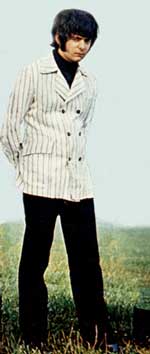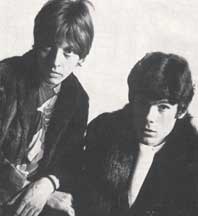|
Pre Purple People This is a fascinating
release for any Deep Purple fan who's familiar with the band's early
catalogue, and has questions about the music that the individual members
were involved in just before they joined... Were elements of Purple already
evident in their work? What would Jon Lord and
Ritchie Blackmore The collection kicks off way back in 1965, with Ritchie Blackmore's ultra-rare (and ultra-tinny) solo single. The musical links to Purple are mainly to the instrumentals that so dominated their early shows, in particular a run in 'Getaway' later jammed around during 'Wring That Neck'. On to early 1967, and getting closer to the formation of Deep Purple, we have three brilliantly quirky sixties instrumentals from Santa Barbara Machine Head, Jon Lord's previous attempt to leave behind the rapidly dating r&b sound of The Artwoods. The group comprised Jon, Twink (Pink Fairies and Pretty Things drummer), Ronnie Wood, and the late Kim Gardner (who ended up in another extremely potent Hammond-driven group, Ashton Gardner & Dyke). Wood's guitar work throughout is hilariously individual, what Ritchie Blackmore might have sounded like with a crate of brown ale in him. But it's still brilliant, I've never heard Wood sound better (certainly not in the Rolling Stones) The Artwoods finally came to a halt in 1967, after trying their hand as a gangsta r&b combo. While Jon was jamming with Ritchie Blackmore and Chris Curtis in his Fulham flat that December, and probably already realising that he'd be needing other musicians with a stronger grip on reality to do the singing and drumming, Slough band The Maze were laying down some deeply unpurple music. 'Cateri Cateri' and 'Easy Street' aren't their best moments, but do show off Rod Evans superb crooning voice, and prove that Ian Paice could restrain himself during quieter numbers, though barely. (This is a full year before he packed an album's worth of drumming into the harpsichord ballad 'Blind').
Were Gillan and Glover
asked to join Purple purely as musicians, or as a writing team?
The four Episode Six tracks help give some clues, especially
the two live Gillan / Glover penned tracks from 1969. These are what
Lord and Blackmore would have witnessed when they checked out Episode
Six, having already decided to David Coverdale's group, The Government, played support for Deep Purple Mk2 at one of their early shows. Just in case the new boy from Episode Six didn't work out, Jon Lord took Coverdale's number. As it was, Purple's career took off big time, and while 'In Rock' was taking up residence in the UK album charts, The Government were trooping into the studio purely to make souvenir recordings for themselves. The resulting four tracks give us our only glimpse of Coverdale's pre-Purple career (for pics see The Government photos in the dp.net image gallery). The band have a choppy guitar and brass soul sound, San Francisco in Sunderland. David is instantly recognisable, and it's a wonder that he had to wait another three years before a big-time recording contract came his way. The quality of music on the cd (and the sound quality) is variable but never dull, and the collection is well worth getting hold of, deserving a place on the cd rack alongside Deep Purple's early catalogue. review: David Browne Pre Purple People is available from the Deep Purple online store |

 have
witnessed when they first checked out Gillan and Glover in Episode Six? Did Deep Purple Mk1 perform sessions for other artists? Whatdid David Coverdale's music sound like before 'Burn' changed his life?
have
witnessed when they first checked out Gillan and Glover in Episode Six? Did Deep Purple Mk1 perform sessions for other artists? Whatdid David Coverdale's music sound like before 'Burn' changed his life? The most interesting tracks
for me come from Deep Purple Mk1 producer Derek Lawrence's archives. Even while
Purple were at South Mimms trying to sort out their line-up, including
surreptitiously swapping hapless greaser Bobby Woodman-Clarke in favour
of Ian Paice, they were being packed into cars and driven away to play
on recordings for Derek's other artists. The two Dylan tracks by
Boz are peppered with 1968 vintage Blackmore wah-wah guitar bursts.
Steadily more and more obscure are vocal duos Sundragon (photographed
on the right) and Anan. Very, very sixties psych-pop, at times
a cross between Deep Purple and The Fifth Dimension. Sundragon's version
of The Byrds' 'I Want To Be A Rock & Roll Star' is a highlight of
the cd, with Blackmore having a great time soloing over the backing.
It's just about possible to imagine Deep Purple Mk1 having a go at the
track, and even making it one of their more successful covers.
The most interesting tracks
for me come from Deep Purple Mk1 producer Derek Lawrence's archives. Even while
Purple were at South Mimms trying to sort out their line-up, including
surreptitiously swapping hapless greaser Bobby Woodman-Clarke in favour
of Ian Paice, they were being packed into cars and driven away to play
on recordings for Derek's other artists. The two Dylan tracks by
Boz are peppered with 1968 vintage Blackmore wah-wah guitar bursts.
Steadily more and more obscure are vocal duos Sundragon (photographed
on the right) and Anan. Very, very sixties psych-pop, at times
a cross between Deep Purple and The Fifth Dimension. Sundragon's version
of The Byrds' 'I Want To Be A Rock & Roll Star' is a highlight of
the cd, with Blackmore having a great time soloing over the backing.
It's just about possible to imagine Deep Purple Mk1 having a go at the
track, and even making it one of their more successful covers. ditch Evans and Simper. 'I Am a Cloud'
and especially 'I Am The Boss' do not sound anything like Mk1 or even
early Mk2 compositions, or like anyone
else for that matter (except Arthur Lee's Love when the guitarist makes
his presence felt), though Syd Barrett could almost have written the
lyrics for the second track. The quality of performance is there all
the way through however, but without a real punch, indicating that both
parties could really help each other out. 'Child In Time' was born soon
after.
ditch Evans and Simper. 'I Am a Cloud'
and especially 'I Am The Boss' do not sound anything like Mk1 or even
early Mk2 compositions, or like anyone
else for that matter (except Arthur Lee's Love when the guitarist makes
his presence felt), though Syd Barrett could almost have written the
lyrics for the second track. The quality of performance is there all
the way through however, but without a real punch, indicating that both
parties could really help each other out. 'Child In Time' was born soon
after.